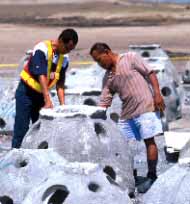|
Newmont Home > Our Social
Responsibility > Environment
Management > Case
Studies > Reef Ball Project
Minahasa Reef Ball Project
Largest of its Kind in the World
A project begun at Newmont’s Minahasa mine in Indonesia in 1999
as part of an overall effort to enhance marine habitat, is now the
largest such private undertaking in the world.
The manufacture of reef balls, used to increase marine habitat
and counter degradation of reefs resulting from unsustainable
fishing practices such as bombing and poisoning of fish, is one part
of Minahasa’s overall Marine Habitat Enhancement program. With
approximately 3,000 reef balls deployed to date, Minahasa’s effort
is second only to a reef ball project implemented by the Malaysian
government.
 The balls are manufactured by local people using moulds
purchased by Newmont. The company also purchased the license for
reef ball manufacturing and provided construction training to the
local residents. In addition to providing direct employment, the
successful deployment of the reef balls has meant increased,
sustainable fishing in the area. Additionally, micro-credit programs
fund local fishing enterprises; providing money for boats, engines,
and cold storage facilities to ensure long-term sustainability of
the area's fishing industry. The balls are manufactured by local people using moulds
purchased by Newmont. The company also purchased the license for
reef ball manufacturing and provided construction training to the
local residents. In addition to providing direct employment, the
successful deployment of the reef balls has meant increased,
sustainable fishing in the area. Additionally, micro-credit programs
fund local fishing enterprises; providing money for boats, engines,
and cold storage facilities to ensure long-term sustainability of
the area's fishing industry.
The success of the project resulted in agreements between Newmont
and two diving centers in Manado which requires Newmont to provide
300 reef balls for establishment of two artificial reefs for the
centers. Other coastal villages have also requested reef ball
deployment in their local waters and plans are underway to extend
the reef ball project to these villages as well.
The other main component of the Marine Habitat Enhancement
program is mangrove rehabilitation and planting. Mangroves grow
along the coast and their root structures help maintain and build
coastlines. Harvesting of mangroves for construction materials has
resulted in significant degradation of fish nursery and feeding
habitat in coastal waters. As in the case of the reef ball project,
mangrove planting is conducted by local people. Mangrove
rehabilitation is planned for a total of five hectares in the local
area. To date, one hectare has been rehabilitated and approximately
10,000 mangrove seedlings of local species produced in the community
nursery.
The Minahasa Marine Habitat Enhancement program was showcased at
the World Summit on Sustainable Development (WSSD) in Johannesburg
in August 2002.
To date, approximately 3,000 of the reef balls, shown here, have
been deployed.
| 


